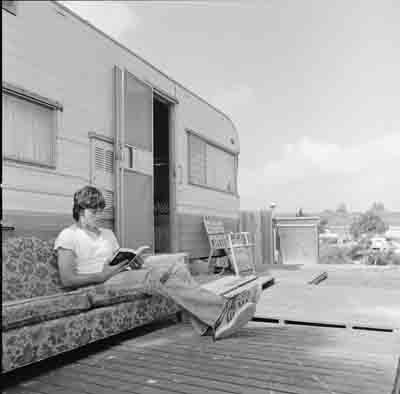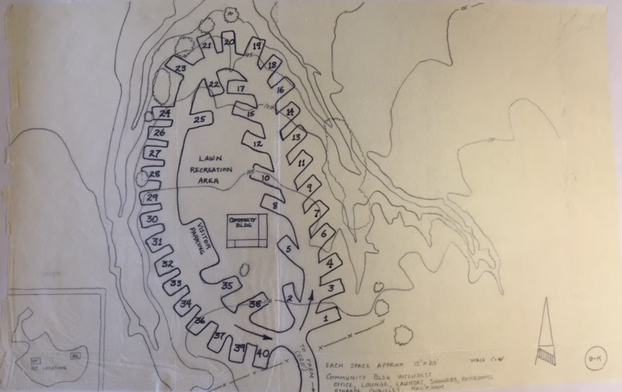
Irvine Meadows, UCI’s first trailer and RV park, circa 1976. From UCI Communications photographs, AS-061, a76-094_003
When UCI first opened in 1965, the city of Irvine did not exist and ranchland covered most of the surrounding area, leaving few options for student housing. UCI’s first dormitory, Mesa Court, housed 500 students in the first year. Although Mesa Court expanded, so too did the number of admitted students. UCI began facing a serious housing shortage on campus. Some students slept in their cars to avoid long commutes and high rent, a common practice in the late sixties and early seventies.
In early 1972, a student group known as the Squatters Club proposed the creation of a camper, van, and RV park. The UCI Housing Office and ASUCI supported the idea. In November that year, Dean of Students Robert Lawrence proposed a plan for the creation of the site to the Campus Planning Committee. Despite wide support for the camper park, nothing was officially established.
Then, in 1973, Irvine and other surrounding cities passed ordinances prohibiting sleeping in cars overnight. This sparked the administration to allocate twelve spaces near the Social Sciences Farm. Occupants were required to have insurance on the vehicle and sign an occupancy agreement. It was named, “Irvine Meadows.”

Student reading outside of his RV in the newly opened Irvine Meadows, circa 1974. From UCI Communications photographs, AS-061, a74-061
By 1976, over 33% of students commuted ten miles or more to get to campus. On-campus housing was completely full and had a waitlist of 1200 students. Irvine Meadows, meant as a temporary location, still existed even though it did not provide utilities or any extra facilities. It had a wait list of over 100 people. With a growing student body the administration again faced a student housing crisis. Administrators including Chancellor Dan Aldrich and the Vice Chancellor of Student Affairs approved a proposal for a site to accommodate 100 vehicles and build bathroom and laundry facilities. In July 1977, the Board of Regents approved funding for the expanded RV park and, after several roadblocks, opened “Irvine Meadows West” on November 15, 1979.
Upon opening, the new RV park did not live up to the original vision nor students’ expectations. The original plan included 100-units, a community building for meeting areas, a kitchen, indoor pool, outdoor recreation facilities and vegetable garden, and complete irrigation and landscaping. The actual site included space for 80 vehicles, a small service building with laundry facilities, and no outdoor recreation, garden, or landscaping. “It’s really no picnic living here,” said John Marinovich, quoted in the New U just weeks after the opening. The first residents reported numerous problems with poor construction and inadequate facilities.
However, by 1982 it was a popular housing alternative and deemed a success by the director of housing and food services. Landscaping was added and it exuded an off-beat, bohemian charm with colorful trailers and a vibrant community. There were plans to expand it, but these were never carried out. In 1999, the administration announced that Irvine Meadows would close in five years. In July 2004, Irvine Meadows closed to make room for new construction.




 Jeff Schneidewind (original IMW resident) says
Jeff Schneidewind (original IMW resident) says
June 1, 2015 at 12:53 pmIn fact, those opening woes John Marinovich mentioned were cleared up within a few months, and campus administrators were incredibly flexible – even allowing IMW residents to take over and self-manage the park. With most residents participating in some way and agreeing on a relatively rule-free “constitution,” it was almost utopia-like for the first few years (at least, compared to other housing options!). Of course, after a few years and sufficient turnover of residents, the vibe faded and things probably got a little out of hand – leading to the eventual closing. When it opened, it was the first of its kind – several other schools had trailer and portable student housing, but UCI’s was the first to allow students to use their own trailers.